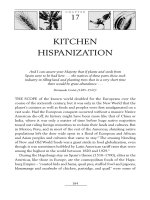KITCHEN HISPANIZATION
Bạn đang xem bản rút gọn của tài liệu. Xem và tải ngay bản đầy đủ của tài liệu tại đây (284.44 KB, 18 trang )
184
CHAPTER
17
KITCHEN
HISPANIZATION
And I can assure your Majesty that if plants and seeds from
Spain were to be had here . . . the natives of these parts show such
industry in tilling land and planting trees that in a very short time
there would be great abundance. . . .
Hernando Cortés (1485–1547)
1
THE SCOPE of the known world doubled for the Europeans over the
course of the sixteenth century, but it was only in the New World that the
planet’s cuisines as well as foods and peoples were fi rst amalgamated on a
vast scale. Had the European conquest occurred without a massive Native
American die-off, its history might have been more like that of China or
India, where it was only a matter of time before huge native majorities
tossed out ruling foreign minorities to reclaim their lands and cultures. But
in Mexico, Peru, and in most of the rest of the Americas, shrinking native
populations left the door wide open to a fl ood of European and African
and Asian peoples and cultures that came to stay.
2
The ensuing blending
of New and Old World foods was a giant stride in food globalization, even
though it was sometimes hobbled by Latin American tariff rates that were
among the highest in the world between 1820 and 1929.
3
During the Hapsburgs stay on Spain’s throne (1516–1700), elites in the
Americas, like those in Europe, ate the cosmopolitan foods of the Haps-
burg Empire – “roasted kids and hams, quail pies, stuffed fowl and pigeons,
blancmange and escabeche of chicken, partridge, and quail” were some of
Kitchen Hispanization
185
these foods that Cortéz and the new Viceroy of New Spain served at a
feast in 1538.
4
But after 1700, when the French Bourbons took over Spain’s helm from
the defunct Hapsburgs, French cuisine became the vogue for the elite
of the Americas and remained so until well into the twentieth century.
French food and the French language were identity cards for the upper
classes who were suffi ciently distanced from Indians and mestizos, blacks
and mulattos, even poor and middle-class whites, so that in Mexico, one of
its upper class members recently confessed that when she was growing up
“we never ate Mexican food.”
5
For most everybody else, however, stews and soups were central to the
diet, just as they were for pre-Columbian peoples who, like the Spaniards,
used ceramic pots for cooking them. Called puchero in Argentina, cazuela
in Chile, chulpe in Peru, and ajiaco in Columbia, such stews blended Old
World ingredients – beef, salt pork, sausage, mutton, and cabbage, rice, and
peas – with those of the New World – sweet and white potatoes, manioc,
maize, annatto, and chilli peppers.
6
With some exceptions, South Americans have not used chilli peppers
as enthusiastically as the Mexicans. Fresh coriander has been a favorite in
the Andean countries as in Mexico, but avocados were and are underuti-
lized in South America. Garlic and onions are universally employed with a
heavy hand, but salads of uncooked greens were rare before the twentieth
century. Bananas and plantai ns were the most important fruits, especially
in lowland locales, although citrus was everywhere. Flan, long the favorite
dessert in the Hispanic countries, was a caramelized milk custard straight
out of the Spanish heritage.
7
THE ABC COUNTRIES
Iberians and Italians were the primary European settlers of Chile, Argentina,
and southern Brazil. In the latter two areas the diet has tended to focus on
grilled or roasted beef, often sun-dried – hardly the near-vegetarian Medi-
terranean diet they left behind. After their early introduction, cattle mul-
tiplied on the pampas so that in the 1840s, beef was so plentiful that it
was even fed to poultry. Today the Plata region (Argentina and Uruguay)
boasts the highest per capita beef consumption in the world, with south-
ern Brazil not far behind. Wheat was the most important of Old World
cereals to reach the region. As in Spain, Italy, and Portugal, it goes mostly
186
A Movable Feast
into white bread, and together meat and wheat transplanted from Europe
to Argentina and Uruguay have helped to feed the world.
8
Mutton is another popular meat in Argentina, where seafood is curiously
underused.
9
In Chile, however, the long, indented 2,600 miles of coastline
yields seafood in abundance, which is consumed in large quantities. Cen-
tral Chile also produces olive oil, another southern European staple.
10
The Italians have contributed pasta to the cuisine as well as tomato-
processing techniques to sun-dry tomatoes and turn them into sauce, puree,
and paste. The Germans, for their part, have played a leading role in the
charcuterie industry. In addition to tomatoes, many other American foods
are routinely employed. In Brazil, toasted manioc meal ( farofa) is invariably
sprinkled over meats and black beans, which constitute the foundation of
feijoada, the country’s national dish – a blending of beans, rice, dried meats,
and sausage.
11
And throughout southern South America potatoes, pumpkins,
squash, green corn, and other corn dishes such as grits are commonly served.
12
Around São Paulo, the dish “ Cuscuz paulista” may have been inspired by the
couscous of North Africa, but cornmeal, not semolina, is used to make it.
13
Coffee, although a nineteeth-century arrival in Brazil, has become South
America’s leading hot beverage, although the native yerba maté tea, made
from the South American holly ( Ilex paraguayensis), remains popular, espe-
cially in Paraguay where Native American males, in particular, suck the brew
from straws, preferably silver, inserted into gourd-like containers.
Iberian colonization brought viticulture to the Americas so that Europe
is very evident in the vineyards that are common in southern Brazil and
blanket the Andes foothills on both the Chilean and Argentinean sides.
14
Long ago, Spanish settlers and Jesuit missionaries elaborated a complex,
but effi cient, system of irrigation for both countries, using water sent down
the mountainsides by melting snowcaps to solve the problem of uncertain
rainfall in a hot and arid climate.
15
Chile produces less wine than Argentina
or Brazil, for that matter, but its wines are better known, although the
Malbec wines of Argentina’s Mendoza region have recently become popular,
led by a number of “Super Mendozans.”
Without vast pampas, Chileans import most of their beef from Argentina
but have many dishes based on pork and mutton as well. Apart from
viticulture, Chile’s agricultural efforts are aimed at the production of
stone fruits and vegetable crops, many of these for export to the United
States. Potatoes are native to the region; other important American foods
are beans (foremost among them the cranberry bean), corn, and squash.
Kitchen Hispanization
187
Interestingly, one of the ancestors of the hybrid garden strawberry is also
a Chilean native.
To journey from the coffee country of southern Brazil to the sugar-
growing regions of the Northeast is to leave an area settled voluntarily
by European immigrants for a region reluctantly peopled by victims of
the African slave trade. It is also to seemingly enter Africa because the
region centered around Bahia showcases many of West Africa’s contribu-
tions to New World cuisine. The American plant manioc is a staple in the
Northeast, but major cooking ingredients like palm or dende oil, okra, and
melegueta peppers are all African in origin.
Bahian cooks lavishly use ingredients such as the meat and milk of coco-
nuts, onions, parsley, bananas, plantains, peppers, and peanuts. Their dishes
are generally based on fi sh, shrimp, and chicken, with dried cod and dried
shrimp both Portuguese contributions to what is otherwise a very tropical
cuisine. Even the names of dishes like vatapá or moqueca evoke the exotic –
fi sh, shrimp, or chicken stews that, when served with rice, represent a
globalizing melding of foods native to the world’s principle continents of
Asia, Africa, the Americas, and Europe.
16
THE ANDEAN REGION
Emphasizing European and African contributions to the American diet is
not meant to minimize native input to New World cuisines. After all, Native
Americans are the ones who domesticated major league crops like manioc,
potatoes, peanuts, and maize, and not surprisingly, today’s diet among the
indigenous peoples in the Andes – in Bolivia, Chile, Peru, and Ecuador –
remains a traditional one, relatively unchanged by the relative newcomers.
Meals rest heavily on a wide variety of potatoes, along with quinoa, maize,
and manioc, often laced with chilli peppers and ground annatto. Meat is eaten
much less frequently in the highlands than elsewhere in South America,
although dishes are sometimes fl avored with the fl esh of chickens as well as
that of the guinea pig ( cuy), a universal favorite that is generally roasted.
17
On the coast, where the Humboldt Current rides herd on a seemingly
inexhaustible supply of seafood, the diet becomes more tropical, utiliz-
ing bananas and plantains, side by side with potatoes but never excluding
them. The minorities of European ancestry clustered in the large cities
do most of the meat-eating and in the nineteenth century, if not before,
European favorites such as beef, mutton, salt pork, and pigs’ feet were all
188
A Movable Feast
available in Lima.
18
Nonetheless, in a land where Quechua is spoken more
commonly than Spanish, outside culinary infl uences are minimal.
19
This
is not, however, the case in the Spanish Main countries of Venezuela and
Columbia. Their llanos, like the pampas to the south, are fenceless ranges
fi lled with cattle and cowboys to tend them.
20
MESOAMERICA
In Mesoamerica (Mexico and Central America), Native American infl uences
have also prevailed after the Europeans arrived. The diet centers on corn,
eaten as posole (hominy), as a green vegetable in season, and, especially as
tortillas. But it also features squash and beans, along with maize, the trinity
of the Mesoamerican diet for millennia, and amaranth. In some places that
plant is utilized for its greens as well as its grains. Produce includes avocados,
tomatoes, tomatillos, chilli peppers, and cacao for a drink and to make mole.
Yet, unlike the highlands of South America, even traditional Mesoamerican
diets contain at least a modicum of globalizing infl uences.
21
Wheat and rice, introduced by the Spaniards, have had a signifi cant
impact on what is eaten, even replacing maize in some cases. Animal pro-
tein supplied by pigs, sheep, goats, cattle, and chickens has had an equally
profound dietary impact, their fat especially useful in fl avoring dishes such
as refried beans and quesadillas , and milk has become central to a fl ourish-
ing cheese-making industry.
In the cities – especially in Mexico City – the diet has become truly
international. Sushi bars, Thai and East Asian restaurants, French-Mexican
cuisine (continuing the French tradition established under the Bourbons
and reinforced during the reign of Maximillian), and traditional Mexican
dishes (although most of these were not prepared before the conquest)
such as chicken and turkey in mole , gorditas , infl adas , empanadas , quesa-
dillas, enchiladas, and refried beans. These join hamburgers, hot dogs, and
pizza in competition for consumers pesos although even some of these
foreign foods get “Mexicanized.” Chillies and salsas are placed atop ham-
burgers and mole and green chilli topping come astride pizza poblanos.
22
Moreover, outlying regions from Puerto Vallarta to Vera Cruz and San
Miguel de Allende to Acapulco serve “fusion” specialties to tourists and
Mexicans alike. Examples include crepes with huitlacoche (a corn fungus),
Caesar salad (said to have been invented in Tijuana), cream of peanut soup,
beef fi let with black truffl e sauce and polenta. But even Mexican specialties
Kitchen Hispanization
189
like hominy and pork soup or mole poblano require European garlic and
onions, and guacamole is often served with sour cream.
THE CARIBBEAN AND THE SPANISH MAIN
Arguably, the Caribbean region, including lowland Mexico, Central America,
and the Spanish Main, has made the greatest advances in food globalization
outside of North America. It was here that Europeans, Native Americans,
and Africans fi rst mingled their blood and cultures on a massive scale, with
yet more mixing taking place after the arrival of immigrants from South
Asia and China. The native staples were zamia, manioc, sweet potatoes,
malanga (tania, yautía), mamey, and, in places, maize, coupled with beans,
chilli peppers, pineapples, guavas, pawpaws, and an assortment of animals
and reptiles such as armadillos, dogs, snakes, and fi sh.
23
In most cases these items remained in a Caribbean diet, enhanced after
1492 by the fl esh and milk of Old World animals, chickpeas, garden pro-
duce, citrus fruits, plantains, bananas, melons, and, of course, sugar cane. In
addition, wheat fl our and salted and pickled fi sh were imported, and the
Europeans also introduced rice from Asia.
24
Africa sent yams, cowpeas, black-eyed peas, pigeon peas, okra, and Guinea
corn (sorghum), ingredients that are turned into West Indian dishes such
as “accara,” or akkra (black-eyed pea fritters), “jug jug” (a haggis-like dish
that incorporates pigeon peas and sorghum), “callaloo” (a thick soup of
greens and okra), “run down” (salted fi sh, coconut milk, and plantains),
and “coo coo” (okra and cornmeal).
25
Later eighteenth-century additions to
Caribbean cuisine include mangoes (from South Asia), ackee (from West
Africa), breadfruit (from the East Indies and Pacifi c tropics), and coffee
(from Arabia).
West Indian slaves consumed manioc and eddoes in stews to which they
added allotments of rice or cornmeal and a little whole protein in the form
of pickled or salted cod, pickled pork and, in the Spanish islands, corned
beef from Argentina. But the caloric expenditures of sugar slaves, along
with the seasonality of many of the root vegetables, often meant outright
malnutrition and a gamut of nutritional diseases.
26
The fall months were
the worst. However, by December the provision crops had matured and
the hurricane season ended so that merchant ships from Europe and the
United States could safely resume the delivery of supplies to the islands.
After months of semi-starvation, the sudden glut of food often produced
190
A Movable Feast
a condition Robert Dirks has termed “relief-induced agonism” – a period
of revelry for the slaves – characterized by feasting, drinking, and a bold
aggressiveness that planters watched with nervous eyes.
27
Another hazard for slaves was lead poisoning. Cheap rum made in stills
with lead fi ttings and pipes provoked the symptoms of the dreaded “dry
belly-ache” – a tortuous attack of intestinal cramps accompanied by pain-
ful constipation.
28
And a fi nal problem was dirt-eating, which signaled
serious nutritional defi ciencies.
29
Not surprisingly, in view of such myriad
nutritional diffi culties, Caribbean slave populations failed to reproduce
themselves which, in turn, perpetuated the slave trade.
Caribbean whites worked hard at maintaining the food traditions of
their mother countries, not an easy matter in the tropics where wheat had
to be imported, fresh meat and cream did not stay fresh for long, and beer
and wine did not keep well either. Consequently, like the meat and fi sh
destined for the slaves, foods consumed by the planters, although of bet-
ter quality, were also salted and pickled, and rum mixed with fruit juices
became the beverage of choice.
30
With the end of slavery in the nineteenth century, Asians – mostly Indian
and Chinese contract laborers – were imported, and also made culinary
contributions to the region.
31
They brought with them masalas (spice,
herb, and seasoning combinations) for curries and techniques for making
roti, a fl atbread that goes well with the curries. They also introduced ghee,
a clarifi ed butter crucial to Hindu cooking, whereas the Chinese brought
with them a knack for steaming fi sh, and stir-frying vegetables.
32
Yet, to qualify an earlier assertion about the extent of Caribbean food
globalization, we must note that the myriad food introductions to the
region along with culinary infl uences remain less than homogenized. In
part, this is because of a plantation past that saw huge differences between
the food preparation and the diets of whites on the one hand, and blacks
and Asians on the other that persist to this day largely because of poverty.
If a trans-Caribbean cuisine can be spied, it is with the bean and rice dishes
found in both the islands and the mainland. Yet, the real food globalization
in the Caribbean today is not found in local dishes but rather in imports:
canned ham, Spam, spaghetti, canned and dried soups, and Nescafe, as well
as in the plethora of McDonald’s, Kentucky Fried Chicken, and Burger
King restaurants, and pizza parlors.
33









